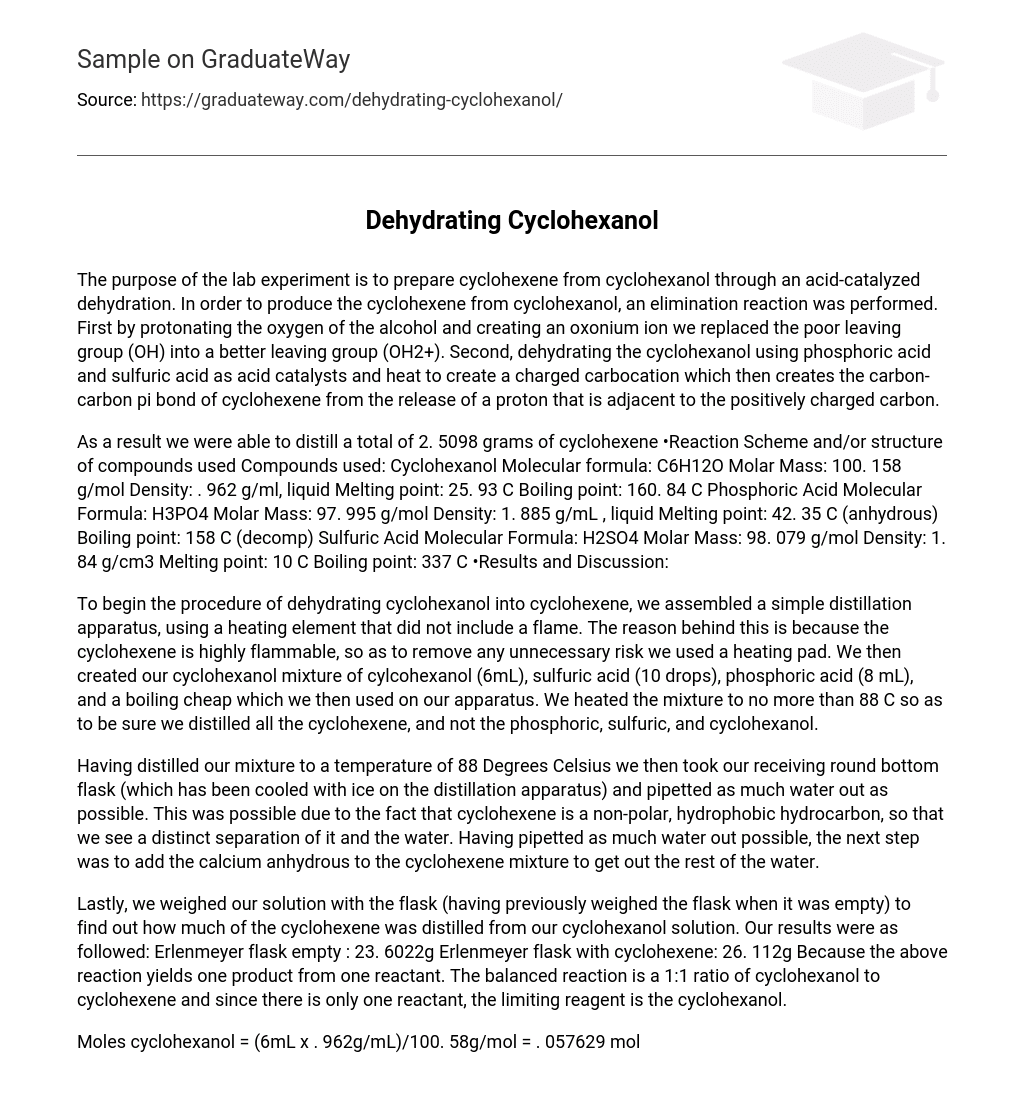The objective of the laboratory experiment was to synthesize cyclohexene from cyclohexanol by utilizing an acid-catalyzed dehydration process. To accomplish this, an elimination reaction was conducted. Initially, the alcohol’s oxygen was protonated, resulting in the formation of an oxonium ion. This substitution effectively replaced the poor leaving group (OH) with a more favorable leaving group (OH2+). Subsequently, the cyclohexanol was dehydrated using phosphoric acid and sulfuric acid as acid catalysts, along with heat. This process generated a charged carbocation, which ultimately facilitated the creation of the carbon-carbon pi bond in cyclohexene through the elimination of a proton adjacent to the positively charged carbon atom.
The distillation process resulted in a total of 2.5098 grams of cyclohexene. The reaction involved the compounds Cyclohexanol, Phosphoric Acid, and Sulfuric Acid.
Cyclohexanol’s properties include: molecular formula – C6H12O, molar mass – 100.158 g/mol, density (liquid) – 0.962 g/ml, melting point – 25.93 C, boiling point – 160.84 C.
Phosphoric Acid’s properties include: molecular formula – H3PO4, molar mass – 97.995 g/mol, density (liquid) – 1.885 g/mL, melting point (anhydrous) – 42.35 C , boiling point (decomp) -158 C.
Sulfuric Acid’s properties include: molecular formula- H2SO4,molar mass-98.079g/mol,density-1.84g/cm3,melting point-10oC,and boiling point-337oC.
The distillation setup for dehydrating cyclohexanol into cyclohexene was arranged without a flame. A heating pad was used instead due to the flammability of cyclohexene. The necessary components, which included 6mL of cyclohexanol, 10 drops of sulfuric acid, 8 mL of phosphoric acid, and a boiling chip, were prepared and added to the apparatus. To distill only the cyclohexene while avoiding the distillation of phosphoric acid, sulfuric acid, and cyclohexanol, the temperature was gradually increased until it reached a maximum of 88 C.
After distilling the mixture to 88 Degrees Celsius, we removed water from our receiving round bottom flask (which had been cooled with ice on the distillation apparatus) using a pipette. This was possible because cyclohexene, being a non-polar and hydrophobic hydrocarbon, separates from water. After removing as much water as possible, we added calcium anhydrous to the cyclohexene mixture to eliminate any remaining water.
Finally, we measured the weight of our solution using a flask. We first weighed the empty flask and then weighed it again after adding the cyclohexene. The measurements were as follows: Erlenmeyer flask empty: 23.6022g, Erlenmeyer flask with cyclohexene: 26.112g. Since the reaction yields one product from one reactant, the balanced reaction has a 1:1 ratio of cyclohexanol to cyclohexene. As there is only one reactant, the limiting reagent is the cyclohexanol.
Moles of cyclohexanol = (6mL x .962g/mL) / 100.58g/mol = .057629 mol
Theoretical yield of cyclohexene: .057629mol x 82.143g/mol = 4.7338g
Actual Yield: 2.5098g
Percent yield: 2.5098g / 4.7338g x 100 = 53% yield.
Reasoning for such a small yield could include the idea that the cyclohexanol was not 100% pure. Another explanation could be that we did not distill the mixture long enough, or that when we pipetted the water from the receiving flask, we accidentally also pipetted some of the product.
Conclusion:
The laboratory demonstrated the practical use of an elimination reaction taught in Organic Chemistry I. It involved converting an OH group into a more suitable leaving group and subsequently eliminating water to yield 2-methyl-2-butene and 2-methyl-1-butene. According to Saytzeff’s rule, the double bond orientation favored the alkene that was more thermodynamically stable, which in this case was 2-methyl-2-butene. Saytzeff’s rule states that the alkene with the highest number of alkyl groups bonded to the carbons of the double bond is preferred.
The experiment’s results did not fully support the theory of the balanced equation stating that one mole of cyclohexanol would produce one mole of cyclohexene. Our collected data only yielded 53% of the initially predicted 4.733 grams. Questions: 1. Determine the percent yield obtained in this experiment. Please refer to the above section on 6.1-methylcyclohexene as per Saytzev’s rule.





